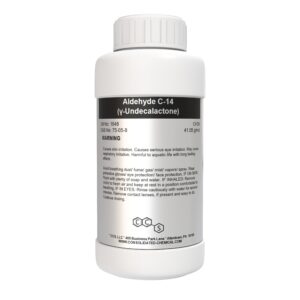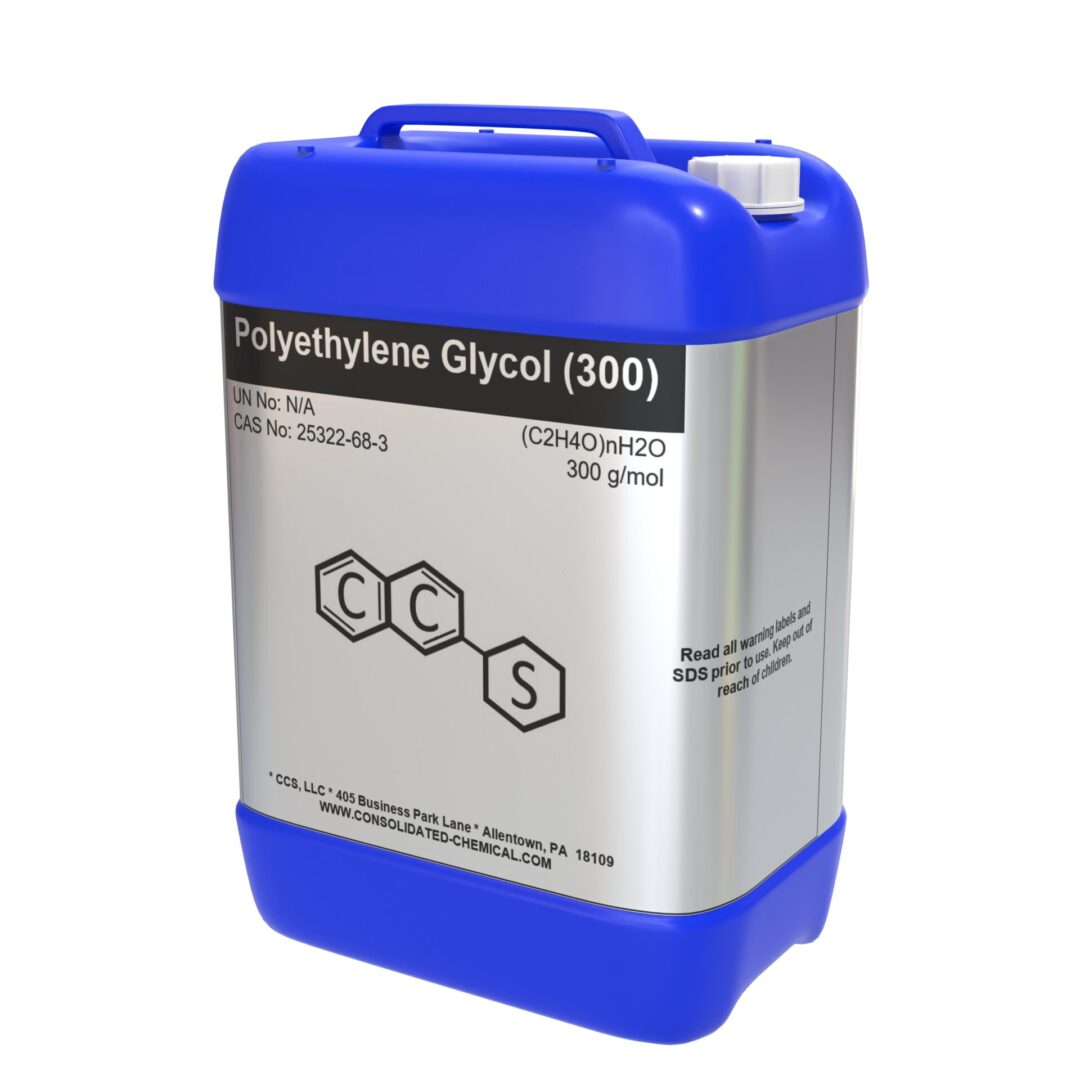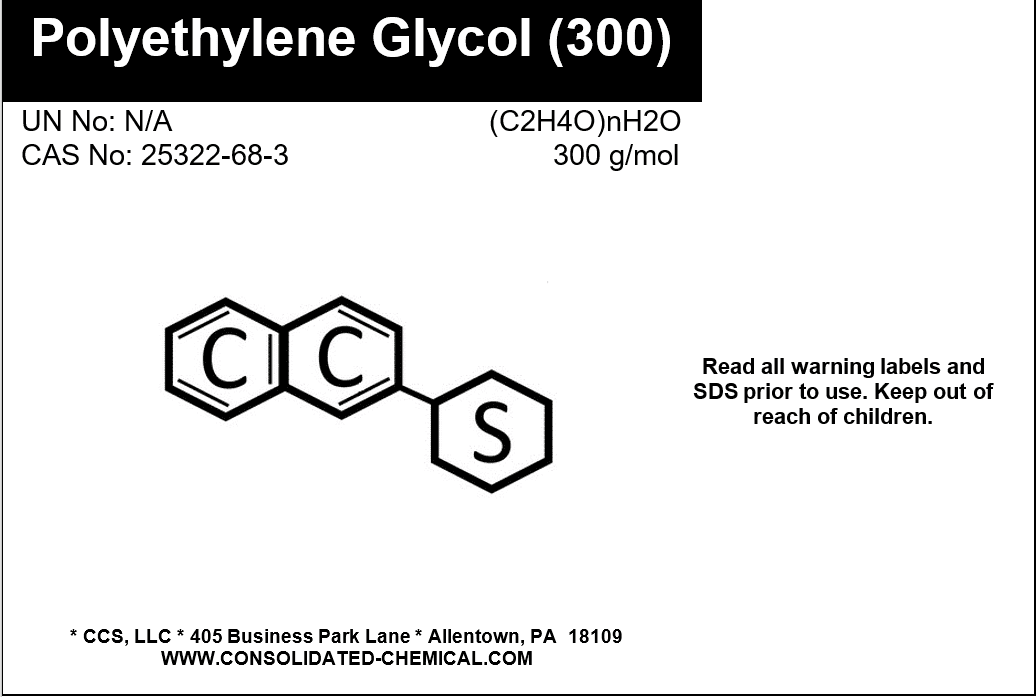Polyethylene Glycol 300 (PEG 300) – Multi-Purpose Solvent
$18.00 – $250.00
Chemical Identity:
- Product Name: Polyethylene Glycol 300 (PEG 300)
- Chemical Formula: HO-(CH₂CH₂O)n-H
- CAS Number: 25322-68-3
- Molecular Weight: ~300 g/mol
Physical Properties
- Appearance: Clear, colorless, odorless liquid
- Odor: Odorless or faintly sweet
- Purity: ≥ 99%
- Density: ~1.12 g/cm³ at 20°C
- Viscosity: ~55–65 cSt at 20°C
- Boiling Point: ~250°C
- Melting Point: -65°C
- Solubility: Fully miscible with water, alcohol, and many organic solvents
- pH (5% Aqueous Solution): Neutral (~5.5–7.0)
Chemical Properties
- Refractive Index (nD): 1.460–1.465 at 20°C
- Evaporation Rate: Very low
- Hygroscopicity: Strong ability to absorb moisture from the air
Description
Polyethylene Glycol 300 (PEG 300) is a clear, water-soluble liquid polymer widely used for its versatility and safety across pharmaceutical, cosmetic, and industrial applications. Known for its exceptional lubricating, moisturizing, and solvent properties, PEG 300 is an essential ingredient in various formulations. With high purity and excellent performance, it is ideal for numerous applications requiring solubility, stability, and non-toxicity.
Applications of Polyethylene Glycol 300 (PEG 300):
Pharmaceutical Industry
- Excipient and Carrier:
- Acts as a solvent and carrier for active ingredients in syrups, injectables, and topical medications.
- Moisturizing Agent:
- Provides hydration in ointments and creams.
- Drug Delivery Systems:
- Improves solubility and bioavailability in oral and parenteral formulations.
Cosmetics and Personal Care
- Humectant:
- Retains moisture and enhances hydration in lotions, creams, and serums.
- Emulsifier:
- Stabilizes formulations in shampoos, conditioners, and body washes.
- Texture Enhancer:
- Improves the texture and spreadability of skincare and haircare products.
Industrial Applications
- Lubricant:
- Provides lubrication in metalworking, machinery, and industrial equipment.
- Plasticizer:
- Enhances flexibility and durability in resins and coatings.
- Dispersant:
- Aids in the dispersion of pigments and particles in paints and inks.
Food Industry
- Food Additive:
- Used as a solvent, stabilizer, and carrier in certain food-grade applications (regulated use).
Research and Development
- Laboratory Solvent:
- Used in chemical and biological research for solubilizing compounds.
- Stabilizer:
- Ensures the stability of reagents and formulations in experimental setups.
Agriculture
- Pesticide Formulations:
- Acts as a carrier and stabilizer in agricultural sprays.
- Animal Feed Additive:
- Helps retain moisture and improve consistency in feed formulations.
Electronics and Automotive
- Coolant and Heat Transfer Fluid:
- Used in cooling systems for electronic devices and automotive applications.
- Cleaning Agent:
- Removes contaminants from electronic and mechanical components.
Environmentally Friendly Applications
- Eco-Friendly Products:
- Utilized in sustainable and biodegradable formulations for industrial and personal care products.
Storage:
- Store in a cool, dry, and well-ventilated area, away from direct sunlight and moisture.
- Keep containers tightly sealed to prevent contamination and moisture absorption.
- Avoid storing near strong oxidizing agents or reactive chemicals.
- Recommended storage temperature: 15°C to 30°C (59°F to 86°F).
- Use clean, dry, and appropriately labeled containers.
Handling:
- Wear appropriate personal protective equipment (PPE), including gloves, goggles, and protective clothing, to avoid skin and eye contact.
- Handle in a well-ventilated area to minimize inhalation of vapors or mist.
- Avoid ingestion or prolonged contact with the product.
- Wash hands thoroughly after handling and before eating, drinking, or smoking.
Safety:
- Skin Contact: Wash affected area with soap and water if irritation occurs.
- Eye Contact: Rinse immediately with plenty of water for several minutes and seek medical attention if irritation persists.
- Inhalation: Move to fresh air; seek medical advice if symptoms develop.
- Ingestion: Non-toxic in small amounts, but seek medical attention if ingested in significant quantities.
Disposal:
- Dispose of Polyethylene Glycol 300 and its packaging in accordance with local, regional, and national regulations.
- Avoid releasing into waterways or the environment.
Additional information
| Size | 500mL (16 Fl Oz), 1000mL (32 Fl Oz), 1 Gallon (128 Fl Oz), 5 Gallon (128 Fl Oz) |
|---|
Related products
-

Silver Nitrate Solution 1% | Reagent Grade
$10.50 Select options This product has multiple variants. The options may be chosen on the product page -

Aldehyde C-14 (Gamma Undecalactone) | Fragrance Compound
$12.00 – $29.99 Select options This product has multiple variants. The options may be chosen on the product page -

Ferrofluid (Liquid Gold) Magnetic Liquid Display 15ML (1/2oz)
$12.99 Select options This product has multiple variants. The options may be chosen on the product page -

Sodium Benzoate Powder – Food Grade
$11.00 – $24.99 Select options This product has multiple variants. The options may be chosen on the product page
SKU: N/A
Categories: Flavoring Agent, Lubricants (8), Pesticide, Solvents (3), Uncategorized
Tags: 25322-68-3, Biodegradable PEG 300, buy PEG 300, Buy PEG 300 Online, Buy Polyethylene Glycol 300, CAS 25322-68-3, Cosmetic Grade PEG 300, Eco-Friendly PEG 300, Food Grade PEG 300, High-Purity PEG 300, Non-Toxic PEG 300, PEG 300, PEG 300 antifreeze agent, PEG 300 Applications, PEG 300 best chemical supplier, PEG 300 best supplier, PEG 300 binder, PEG 300 biodegradability, PEG 300 boiling point, PEG 300 bulk supplier, PEG 300 carrier solvent, PEG 300 CAS 25322-68-3, PEG 300 chemical, PEG 300 chemical structure, PEG 300 commercial availability, PEG 300 competitive pricing, PEG 300 compliance guidelines, PEG 300 cost-effective solutions, PEG 300 cutting-edge technology, PEG 300 density, PEG 300 Dispersant, PEG 300 dispersing agent, PEG 300 distributor, PEG 300 emergency response, PEG 300 emulsifier, PEG 300 environmental impact, PEG 300 EPA regulations, PEG 300 EU regulations, PEG 300 excipient, PEG 300 FDA approved, PEG 300 flexible applications, PEG 300 for Agricultural Use, PEG 300 for Food Applications, PEG 300 for Lotions, PEG 300 for Metalworking, PEG 300 for Paints and Coatings, PEG 300 for Personal Care, PEG 300 for Research, PEG 300 for Serums, PEG 300 GHS classification, PEG 300 global market, PEG 300 hazard classification, PEG 300 Humectant, PEG 300 hypoallergenic, PEG 300 import/export, PEG 300 in 3D printing, PEG 300 in adhesives, PEG 300 in agrochemicals, PEG 300 in alternative energy, PEG 300 in animal feed additives, PEG 300 in antifreeze, PEG 300 in aquaculture, PEG 300 in aroma compounds, PEG 300 in artificial implants, PEG 300 in bakery products, PEG 300 in battery electrolytes, PEG 300 in beverages, PEG 300 in biodegradable solutions, PEG 300 in biofuels, PEG 300 in biomaterials, PEG 300 in biomedical applications, PEG 300 in biotechnology, PEG 300 in body washes, PEG 300 in cell culture, PEG 300 in coatings, PEG 300 in conditioners, PEG 300 in confectionery, PEG 300 in controlled release formulations, PEG 300 in corrosion inhibitors, PEG 300 in cosmetics, PEG 300 in cryoprotectants, PEG 300 in dairy products, PEG 300 in deodorants, PEG 300 in detergents, PEG 300 in dietary supplements, PEG 300 in dishwashing liquids, PEG 300 in dispersions, PEG 300 in drug delivery systems, PEG 300 in drug formulations, PEG 300 in dyes and pigments, PEG 300 in eco-friendly formulations, PEG 300 in edible coatings, PEG 300 in emerging markets, PEG 300 in emulsions, PEG 300 in encapsulation technology, PEG 300 in energy storage, PEG 300 in environmental applications, PEG 300 in essential oils, PEG 300 in fabric softeners, PEG 300 in fertilizers, PEG 300 in food additives, PEG 300 in food emulsions, PEG 300 in food flavorings, PEG 300 in food glazes, PEG 300 in fragrance formulations, PEG 300 in fuel additives, PEG 300 in fuel cells, PEG 300 in functional foods, PEG 300 in gene therapy, PEG 300 in grease formulations, PEG 300 in green chemistry, PEG 300 in hair care, PEG 300 in hand sanitizers, PEG 300 in hand soaps, PEG 300 in heat transfer fluids, PEG 300 in herbicides, PEG 300 in high-tech industries, PEG 300 in household cleaning products, PEG 300 in hydraulic fluids, PEG 300 in hydrogen storage, PEG 300 in industrial cleaners, PEG 300 in industrial coatings, PEG 300 in injectable drugs, PEG 300 in ink formulations, PEG 300 in laundry detergents, PEG 300 in leather treatment, PEG 300 in lip balms, PEG 300 in liquid medications, PEG 300 in livestock health, PEG 300 in lotions, PEG 300 in lubricants, PEG 300 in material science, PEG 300 in medical devices, PEG 300 in medical excipients, PEG 300 in medicine, PEG 300 in metalworking fluids, PEG 300 in moisturizers, PEG 300 in mouthwash, PEG 300 in nanotechnology, PEG 300 in nutraceuticals, PEG 300 in oil refining, PEG 300 in ophthalmic solutions, PEG 300 in oral formulations, PEG 300 in paint formulations, PEG 300 in personal care, PEG 300 in pesticides, PEG 300 in petrochemical processing, PEG 300 in pharmaceutical coatings, PEG 300 in pharmaceuticals, PEG 300 in plant growth regulators, PEG 300 in plastics, PEG 300 in pollution control, PEG 300 in polymer processing, PEG 300 in precision manufacturing, PEG 300 in printing, PEG 300 in protein formulations, PEG 300 in protein stabilization, PEG 300 in renewable products, PEG 300 in resins, PEG 300 in rubbers, PEG 300 in sanitizers, PEG 300 in sealants, PEG 300 in serums, PEG 300 in shampoos, PEG 300 in shaving creams, PEG 300 in skincare, PEG 300 in soil conditioners, PEG 300 in sunscreens, PEG 300 in surface disinfectants, PEG 300 in surfactants, PEG 300 in suspensions, PEG 300 in sustainable production, PEG 300 in syrups, PEG 300 in textiles, PEG 300 in tissue engineering, PEG 300 in toothpaste, PEG 300 in topical creams, PEG 300 in transdermal patches, PEG 300 in vaccine formulations, PEG 300 in veterinary medicine, PEG 300 in wastewater treatment, PEG 300 in water purification, PEG 300 industrial safety, PEG 300 industry demand, PEG 300 industry partnerships, PEG 300 industry-leading product, PEG 300 innovative solutions, PEG 300 international trade, PEG 300 long shelf life, PEG 300 Lubricant, PEG 300 manufacturer, PEG 300 market trends, PEG 300 melting point, PEG 300 moisture retention, PEG 300 molecular formula, PEG 300 molecular weight, PEG 300 MSDS, PEG 300 next-generation applications, PEG 300 non-toxic, PEG 300 non-volatile, PEG 300 oil-soluble, PEG 300 oxidation stability, PEG 300 Packaging, PEG 300 personal protective equipment, PEG 300 pH stability, PEG 300 pharmaceutical grade, PEG 300 Plasticizer, PEG 300 premium quality, PEG 300 REACH certified, PEG 300 reactivity, PEG 300 regulatory compliance, PEG 300 regulatory updates, PEG 300 research and development, PEG 300 safe handling, PEG 300 safety data sheet, PEG 300 SDS, PEG 300 shelf-stable, PEG 300 solubility, PEG 300 solubilizer, PEG 300 Solvent, PEG 300 spill management, PEG 300 stabilizer, PEG 300 strategic sourcing, PEG 300 superior performance, PEG 300 supply chain optimization, PEG 300 surfactant, PEG 300 transport regulations, PEG 300 US regulations, PEG 300 verified distributor, PEG 300 verified supplier, PEG 300 viscosity, PEG 300 viscosity modifier, PEG 300 waste disposal, PEG 300 water-soluble, PEG 300 wetting agent, PEG 300 wholesale, Pharmaceutical Grade PEG 300, Polyethylene Glycol 300, Polyethylene Glycol 300 Bulk, Polyethylene Glycol 300 for Cosmetics, Polyethylene Glycol 300 for Haircare, Polyethylene Glycol 300 for Industrial Use, Polyethylene Glycol 300 for Pharmaceuticals, Polyethylene Glycol 300 for Skincare, Polyethylene Glycol 300 Price, Polyethylene Glycol 300 Supplier, Sustainable Polyethylene Glycol











